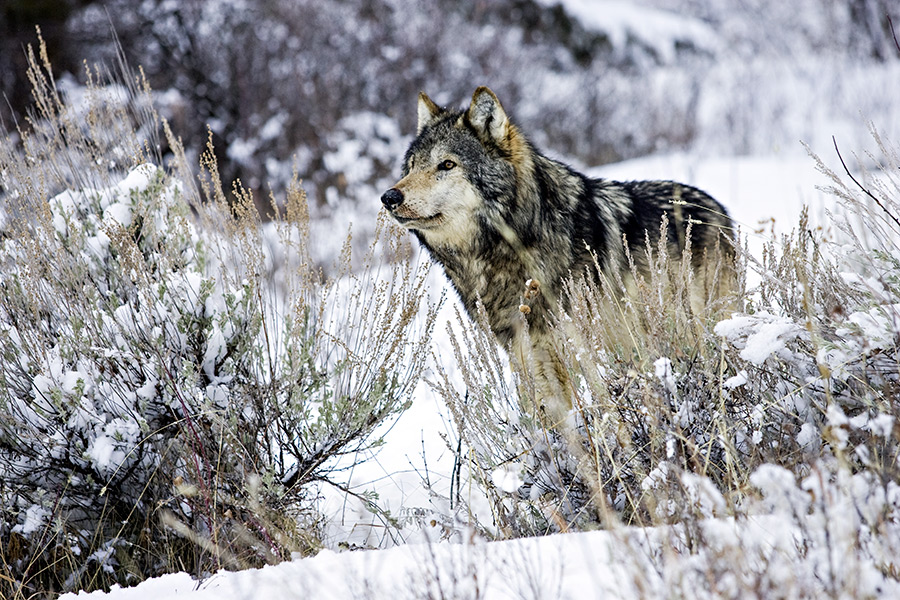With only a few days remaining before the end of Montana’s general wolf-hunting season on March 15, a record 315 wolves have been harvested across the state, with the bulk of them taken before cold temperatures and heavy snows made hunting and trapping conditions more difficult.
As of March 10, preliminary results from Montana Fish, Wildlife and Parks (FWP), the agency tasked with managing the elusive predators, indicate that hunters harvested 165 wolves and trappers killed 130. Train and automobile collisions were responsible for three mortalities, according to FWP.
The U.S. Department of Agriculture’s Wildlife Services Division killed eight wolves after investigating reports of livestock depredation and other conflicts, while private landowners killed two. FWP lists the cause of one mortality as “unknown,” another mortality as “other” and five wolf mortalities as “illegal.”
Of those preliminary totals, 111 wolves were killed in FWP’s Region 1 in Northwest Montana, which is home to the state’s densest wolf population.
Recent population estimates — figures arrived at through a method known as patch occupancy modeling (POM) — peg Montana’s wolf population at about 850 animals statewide, with around 350 living in Region 1.
This hunting season, the state sold about 17,000 wolf licenses, according to preliminary figures. That’s down from 2013, when wolf hunters bought 24,000.
The state assumed management over the species in 2011, when wolves, once hunted to near extirpation, were delisted from the federal Endangered Species Act.
During the 2017-18 season, hunters and trappers took 254 wolves, with 166 by hunters and an additional 88 by trapping. Total wolf mortality was about 305 wolves.
In Montana, archery season for wolves ran from Sept. 1-14, 2018. General hunting season runs from Sept. 15, 2018 through March 15, 2019, while trapping season ran Dec. 15, 2018, through Feb. 28, 2018.
Neil Anderson, wildlife program manager for FWP’s Region 1, attributes the record wolf harvests to the state’s relatively mild winter in December and January, when most of the hunting-related mortalities were totaled.
Between September 2018 and December 2018, for example, 166 wolves were killed, compared to 98 in January 2019 and 47 in February, according to FWP’s preliminary figures.
“I think it had to do with the conditions on the ground, especially for trapping,” Anderson said. “We had a pretty mild December, with not a lot of snow and not a lot of changes in snow patterns. That’s more conducive for folks to get out and get after them. When the temperatures dropped and the snow started accumulating, traps start to freeze up, and we saw the harvests really taper off toward the end of the season.”
Another factor contributing to the uptick in wolf harvests, Anderson said, is the number of hunters pursuing the animal as big game while honing their hunting and trapping chops in the field.
“More people are figuring out this whole wolf-hunting thing, which takes a lot of effort and knowledge,” he said. “These are smart animals.”
The subject of wolves on the landscape has been a contentious one this legislative session, particularly as hunters complain that the state’s wolf population has had an increasingly adverse impact on deer, elk and moose populations in recent years, as evidenced by below-average ungulate harvests, even as wildlife managers attribute the fluctuating harvests to a mixed bag of environmental factors, including back-to-back heavy winters that reduced fawn recruitment.
During the first half of the legislative session, lawmakers on both sides of the political aisle proposed a host of wolf-related measures, some of which generated controversy. Among the most controversial was a bill to allow hunting wolves at night, another to reduce trapping setbacks on seasonally closed roads and still another to reimburse licensed wolf trappers for their costs, which will head to the Senate Fish and Game Committee March 21.
The other bills, both introduced by Rep. Bob Brown, R-Thompson Falls, who also introduced the reimbursement measure, didn’t survive the session’s midway transmittal point, but others have gained bipartisan support.
Nick Gevock, conservation director for the Montana Wildlife Federation, said his organization supports Brown’s bills to decrease the cost of resident wolf licenses, as well as others that would provide discounts to certain license holders, such as those who purchase a combination sportsman license.
Although Gevock opposed the measure to allow wolf hunting at night, he emphasized the importance of the role hunters and trappers play in managing the state’s wolf population.
“We have supported a package of bills that lower the cost of wolf hunting, and we have worked with Rep. Brown on them,” he said. “We want to have ethical, fair-chase wolf hunters in the field helping to manage the species, but we also want to keep the wolf population healthy. They are a difficult species to hunt, and I think Montana hunters and trappers are stepping up and showing that they are able to get the job done. I think that’s reflective in this year’s record wolf harvests.”
Correction: An earlier version of this story inaccurately reported that House Bill 279, which would reimburse trappers for their expenses, did not survive the Legislature’s transmittal deadline. The Senate Fish and Game Committee will hold a hearing on the bill March 21.
